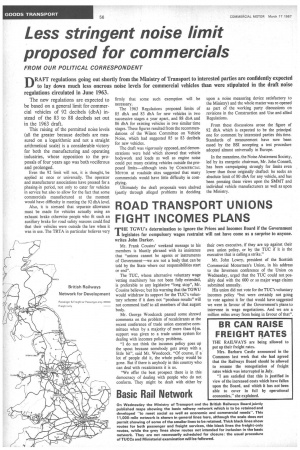Less stringent noise limit proposed for commercials
Page 58

If you've noticed an error in this article please click here to report it so we can fix it.
FROM OUR POLITICAL CORRESPONDENT DRAFT regulations going out shortly from the Ministry of Transport to interested parties are confidently expected to lay down much less onerous noise levels for commercial vehicles than were stipulated in the draft noise regulations circulated in June 1963.
The new regulations are expected to be based on a general limit for commercial vehicles of 92 decibels (dbA) instead of the 83 to 88 decibels set out in the 1963 draft.
This raising of the permitted noise levels (all the greater because decibels are measured on a logarithmic and not a straight arithmetical scale) is a considerable victory for both the manufacturing and operating industries, whose opposition to the proposals of four years ago was both vociferous and prolonged.
Even the 92 limit will not, it is thought, be applied at once or universally. The operator and manufacturer associations have pressed for a phasing-in period, not only to cater for vehicles in service but also to allow for the fact that some commercials manufactured at the moment would have difficulty in meeting the 92 dbA level.
Also, it is stressed that separate allowance must be made for vehicles actually using an exhaust brake otherwise people who fit such an auxiliary brake for road safety reasons could find that their vehicles were outside the law when it was in use. The TRTA in particular believes very firmly that some such exemption will be necessary.
The 1963 Regulations proposed limits of 85 dbA and 83 dbA for new vehicles in two successive stages a year apart, and 88 dbA and 86 dbA for existing vehicles in two similar time stages. These figures resulted from the recommendations of the Wilson Committee on Vehicle Noise, which had suggested 85 to 83 decibels for new vehicles.
The draft was vigorously opposed, and demonstrations were held which showed that vehicle bodywork and loads as well as engine noise could put many existing vehicles outside the proposed limits—although tests by COMMERCIAL MOTOR at roadside sites suggested that many commercials would have little difficulty in complying.
Ultimately the draft proposals were shelved (partly through alleged problems in deciding upon a noise measuring device satisfactory to the Ministry) and the whole matter was re-opened as part of the working party discussions on revisions in the Construction and Use and allied Regulations.
From these discussions arose the figure of 92 dbA which is expected to be the principal one for comment by interested parties this time. Standards of measurement have now been eased by the BSI accepting a test procedure adopted almost universally in Europe.
In the meantime, the Noise Abatement Society, led by its energetic chairman, Mr. John Connell, has been campaigning strongly for limits even lower than those originally drafted: he seeks an absolute limit of 80 dbA for any vehicle, and has been pressing these views upon the SMMT and individual vehicle manufacturers as well as upon the Ministry.








































































































































































































